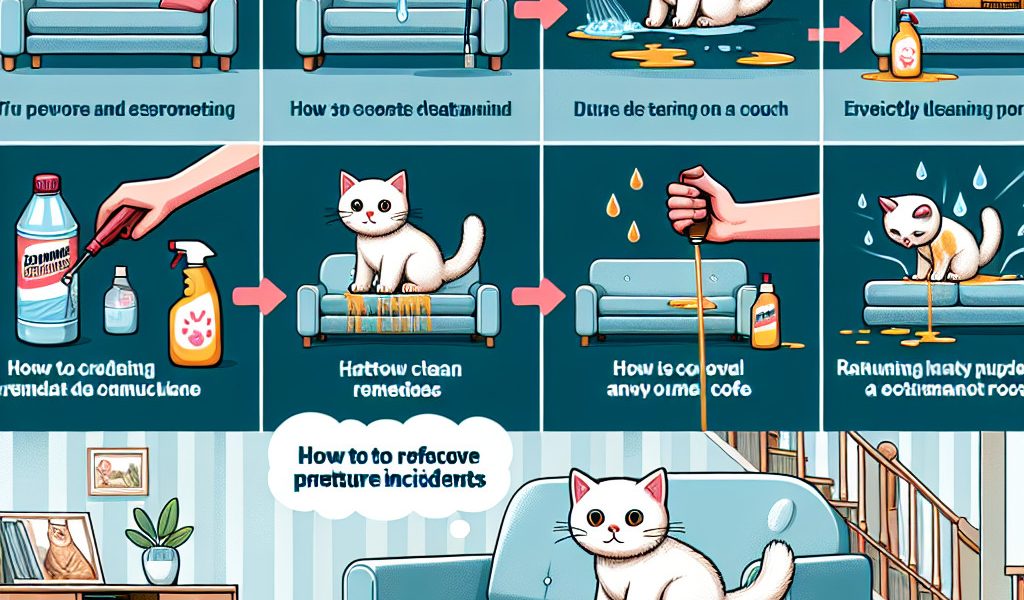Banishing the Pungent Paws: Proven Techniques and Preventive Measures for Eliminating Cat Urine Odor from Your Sofa
Introduction
Pet owners, especially cat owners, are often faced with unpleasant situations like the one where their feline urinated on the sofa. Besides the stain, the lingering smell of cat pee can be very annoying. In this article, we present effective methods for removing this unpleasant odor from different types of materials, as well as preventative tips to prevent your cat from repeating this behavior.
Commercial Methods to Remove Cat Pee Smell
There are several products specifically designed to eliminate pet urine odors. Here are some of the most popular business solutions:
- Enzymatic cleaners: These cleaners contain enzymes that break down the molecules responsible for bad odors. They are generally effective on all types of materials (fabric, leather or imitation leather). Be sure to follow the manufacturer’s instructions carefully before use.
- Animal specific stain removers: Some stain removers are specially formulated to deal with stains and odors caused by pets. They can be used on a variety of surfaces such as fabric, leather and faux leather. Again, follow the manufacturer’s instructions for the best results.
- Odor absorbers: Odor absorbers are products that capture and neutralize odors without necessarily cleaning the surface. They can be used in addition to prior cleaning with another product. These absorbers are often in the form of granules or powder to sprinkle on the affected area.
Home Methods to Remove Cat Pee Smell
If you prefer to use natural and economical solutions, here are some effective home methods:
- White vinegar: White vinegar is an excellent natural deodorizer that can be used on most materials, including fabric and leather. Mix one part white vinegar with two parts lukewarm water in a spray bottle. Lightly spray the solution onto the affected area and leave for 10 minutes before blotting with a clean cloth.
- Baking soda: Baking soda is also very effective in eliminating stubborn odors like cat pee. Generously sprinkle bicarbonate over the affected area and leave to act for several hours (or even overnight). Then carefully vacuum up the bicarbonate using a vacuum cleaner.
- Hydrogen peroxide: Hydrogen peroxide can be used on fabrics to eliminate the smell of cat pee. Mix one part 3% hydrogen peroxide with two parts water in a spray bottle. Lightly spray the solution onto the affected area and leave for a few minutes before blotting with a clean cloth. Be careful, hydrogen peroxide can discolor some fabrics, so always test on a small, inconspicuous area before use.
Preventive tips to prevent your cat from urinating outside its litter box
To reduce the risk of your cat urinating on the couch or elsewhere in the house, here are some preventative tips:
- Maintain litter box cleanliness by regularly removing droppings and completely changing the substrate at least once a week.
- Place multiple litter boxes in different areas of your home if you have multiple cats, so they each have their own personal space to do their business.
- Spay or neuter your cat, as this can reduce territorial urine marking behaviors.
- Avoid stressful situations for your cat that can lead to urinary problems (for example: frequent moves, sudden changes in the environment, introduction of new animals).
- Consult a veterinarian to rule out any health problems that may be causing the inappropriate behavior.
The importance of understanding the reasons behind this behavior
Finally, it is essential to try to understand why your cat is urinating outside of its litter box. The causes can be varied: medical problems (urinary infections, kidney stones), stress or anxiety, poor management of litter boxes, etc. By identifying and treating the underlying cause of the problem, you not only improve your pet’s quality of life and overall well-being but also your own comfort within the home.
